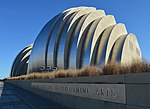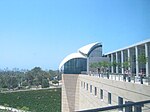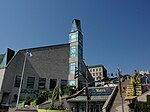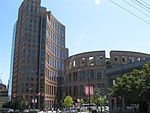Moshe Safdie
Moshe Safdie | |
|---|---|
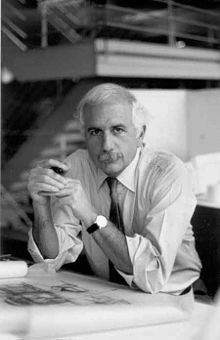 (2004) | |
| Born | July 14, 1938 |
| Nationality | Israeli, Canadian |
| Alma mater | McGill School of Architecture |
| Occupation | Architect |
| Awards | AIA Gold Medal Order of Canada Gold Medal of the Royal Architectural Institute of Canada |
| Practice | Safdie Architects |
| Buildings | Habitat 67 Asian University for Women Virasat-e-Khalsa Marina Bay Sands National Gallery of Canada Yad Vashem Altair Jewel Changi Airport Raffles City Chongqing |
| Projects | Alrov Mamilla Quarter |
Moshe Safdie CC FAIA FRAIC (Hebrew: משה ספדיה; born July 14, 1938) is an Israeli-Canadian architect, urban designer, educator, theorist, and author. He is most identified with designing Marina Bay Sands and Jewel Changi Airport, as well as his debut project Habitat 67, which was originally conceived as his Master's thesis while studying at McGill University and paved the way for his international career.[1][2]
Personal life and education
Safdie was born in Haifa in the British Mandate of Palestine (now Israel), to Sephardic Jewish family of Syrian-Jewish and Lebanese-Jewish descent. In 1954, his family moved to Montreal, Quebec and in 1959, Safdie married Nina Nusynowicz, a Polish-Israeli, with whom he has two children, a daughter and son.[3] His son Oren Safdie is a playwright who has written several plays about architecture.[4] and his daughter Taal is an architect in San Diego, a partner of the firm Safdie Rabines Architects.[5]
In 1961, Safdie received his master's degree in Architecture from the McGill University School of Architecture.
Career
After apprenticing with Louis Kahn in Philadelphia, Safdie returned to Montreal to oversee the master plan for Expo 67. In 1964, he established his own firm to undertake Habitat 67, an adaptation of his McGill thesis. Habitat 67, which pioneered the design and implementation of three-dimensional, prefabricated units for living, was a central feature of Expo 67 and an important development in architectural history. He was awarded the 1967 Construction Man of the Year Award from the Engineering News Record and the Massey Medal for Architecture in Canada for Habitat 67.[6]

In 1970, Safdie opened a branch office in Jerusalem. Among the projects he has designed in Jerusalem are Yad Vashem and the Alrov Mamilla Quarter, which includes the Mamilla Mall, David's Village luxury condominiums, and the 5-star Mamilla Hotel. In 1978, after teaching at McGill, Ben Gurion, and Yale universities, Safdie moved his main office to Boston and became director of the Urban Design Program at Harvard University's Graduate School of Design, until 1984. From 1984 to 1989, he was the Ian Woodner Professor of Architecture and Urban Design at Harvard. Since the early-1990s, Safdie, a citizen of Canada, Israel, and the United States, has focused on his architectural practice, Safdie Architects, which is based in Somerville, Massachusetts, and has branches in Toronto, Jerusalem, and Singapore.
Safdie has designed six of Canada's principal public institutions—including the National Gallery of Canada in Ottawa, and Vancouver Library Square—as well as many other notable projects around the world, including the Salt Lake City Main Public Library; the Khalsa Heritage Centre in Punjab, India; the Marina Bay Sands integrated resort in Singapore; the United States Institute of Peace Headquarters in Washington, DC; the Kauffman Center for the Performing Arts in Kansas City, Missouri; and the Crystal Bridges Museum of American Art in Bentonville, Arkansas; as well as his latest achievment Jewel Integrated airport in Singapore.
Style


Moshe Safdie's works are known for their dramatic curves, arrays of geometric patterns, use of windows, and key placement of open and green spaces. His writings and designs stress the need to create meaningful, vital, and inclusive spaces that enhance community, with special attention to the essence of a particular locale, geography, and culture. He is a self-described modernist.
Awards and recognition
- Gold Medal, American Institute of Architects
- Companion of the Order of Canada
- Gold Medal, Royal Architectural Institute of Canada
- Richard Neutra Award for Professional Excellence
- Mt. Scopus Award for Humanitarianism, Jerusalem
- Wolf Prize in Arts (Architecture), 2019[7]
- Honorary Doctorate, Technion - Israel Institute of Technology, 2019[8]
In November 2011, Punjab Chief Minister honoured Safdie at the inauguration ceremony of the Khalsa Heritage Museum. He said Safdie had studied the Sikh religion for two years before designing the museum. Safdie said he wanted the museum to look 300 years old and he thought he had succeeded in this objective.[citation needed]
Personal life
In 1981, Safdie married Michal Ronnen, a Jerusalem-born photographer[9], with whom he has two daughters, Carmelle and Yasmin. Carmelle Safdie is an artist, and Yasmin Safdie is a social worker. He is the uncle of Dov Charney, founder and former CEO of American Apparel. He is the great-uncle of the Safdie brothers, the filmmakers behind the 2017 film Good Time and the 2019 film Uncut Gems.
Selected projects
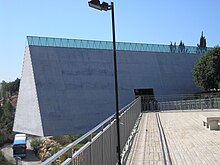

- 1967 Habitat 67 at Expo 67 World's Fair, Montreal, Quebec, Canada
- 1980-1982 Urban planning and tourist/recreational centre, Robina, Gold Coast, Queensland, Australia[10]
- 1981 Coldspring New Town, Baltimore, Maryland, US
- 1984 International Monetary Fund Headquarters, Washington, D.C.
- 1987 Musée de la Civilisation, Quebec City, Canada
- 1988 The National Gallery of Canada, Ottawa, Ontario, Canada
- 1988 Hebrew Union College, Jerusalem, Israel
- 1989 City plan for Modi'in, Israel
- 1989 The Esplanade condominium complex in Cambridge, Massachusetts, US
- 1991 The Jean-Noël Desmarais Pavilion of the Montreal Museum of Fine Arts, Montreal, Quebec, Canada
- 1992 The Class of 1959 Chapel, Harvard Business School, Cambridge, Massachusetts, US
- 1993 Mamilla Centre and David's Village, Jerusalem, Israel
- 1994 Former Ottawa City Hall, Ottawa, Ontario, Canada
- 1995 Vancouver Library Square, Vancouver, British Columbia, Canada
- 1995 The Centre in Vancouver for the Performing Arts, Vancouver, British Columbia, Canada
- 2000 The Exploration Place Science Museum in Wichita, Kansas, US
- 2002 The campus of Hebrew College in Newton, Massachusetts, US
- 2003 Peabody Essex Museum in Salem, Massachusetts, US[11]
- 2003 Main Branch of the Salt Lake City Public Library, Salt Lake City, Utah, US
- 2003 Eleanor Roosevelt College campus, University of California San Diego, US
- 2003 Pantages Tower, Toronto, Ontario, Canada
- 2003 Corrour Lodge, Inverness-shire, Scotland
- 2004 Airside building of Terminal 3, Ben Gurion International Airport, Tel Aviv, Israel
- 2005 Yad Vashem Holocaust History Museum, Jerusalem, Israel; the Children's Memorial and Deportees (cattle-car) Memorial are also Safdie designs
- 2006 Telfair Museum of Art, Jepson Center for the Arts, Savannah, Georgia, US
- 2007 Terminal 1, Toronto Pearson International Airport, Toronto, Ontario, Canada, (with Skidmore, Owings & Merrill)
- 2008 United States Federal Courthouse, District of Massachusetts, Springfield, Massachusetts, US
- 2008 Headquarters for the Bureau of Alcohol, Tobacco, Firearms, and Explosives (ATF), Washington, D.C., US
- 2009 Asian University for Women, Chittagong, Bangladesh[12]
- 2009 Mamilla Center, Jerusalem, Israel
- 2010 Yitzhak Rabin Center, Tel Aviv, Israel
- 2010 Marina Bay Sands, Singapore
- 2011 United States Institute of Peace Headquarters, Washington, D.C., US
- 2011 Kauffman Center for the Performing Arts, Kansas City, Missouri, US
- 2011 Crystal Bridges Museum of American Art, Bentonville, Arkansas, US
- 2011 Khalsa Heritage Memorial Complex (Virasat-e-Khalsa), Anandpur Sahib, Punjab, India
- 2013 Skirball Cultural Center, Los Angeles, California, US
- 2012 Sky Habitat, Singapore[13]
- 2012 Schottenstein campus of the Israel Antiquities Authority, Jerusalem, Israel
- 2013 Altair Towers, Colombo, Sri Lanka
- 2019 Raffles City Chongqing, China
- 2019 Jewel Changi Airport, Singapore
- 2019 Technion - Israel Institute of Technology, Israel
Gallery
-
Kauffman Center for the Performing Arts, Kansas City, Missouri
-
The Class of 1959 Chapel, Boston, Massachusetts
-
Peabody Essex Museum, Salem, Massachusetts
-
Yitzhak Rabin Center, Tel Aviv
-
Musée de la Civilisation, Quebec City
-
Ottawa City Hall, Ottawa
-
National Gallery of Canada, Ottawa
-
Salt Lake City Public Library, Utah
-
Vancouver Library Square, Vancouver, British Columbia
-
Crystal Bridges Museum of American Art, Bentonville, Arkansas
-
Marina Bay Sands, Singapore
-
Skirball Cultural Center, Los Angeles, California
-
United States Institute of Peace Headquarters, Washington, D.C.
-
Khalsa Heritage Memorial Complex, Anandpur Sahib, India
Published works
- Beyond Habitat (1970)
- For Everyone A Garden (1974)
- Form & Purpose (1982)
- Beyond Habitat by 20 Years (1987)
- Jerusalem: The Future of the Past (1989)
- The City After the Automobile: An Architect's Vision (1998)[14]
- Yad Vashem - The Architecture of Memory (2006)[15]
See also
References
Notes
- ^ Dvir, Noam (2012-02-03). "Israeli Architecture With Eastern Promise". Haaretz. Retrieved 2016-04-04.
- ^ Moshe Safdie to receive the 2015 AIA Gold Medal 10 Dec 2014
- ^ Master Builder Haaretz. 18 January 2007
- ^ Kaufman, Joanne. "Deconstructing Architecture". Wall Street Journal. ISSN 0099-9660. Retrieved 2016-04-04.
- ^ "HOME". Safdie Rabines Architects. Retrieved 2016-04-04.
- ^ Pound, Richard W. (2005). 'Fitzhenry and Whiteside Book of Canadian Facts and Dates'. Fitzhenry and Whiteside.
- ^ Wolf Prize 2019 - Jerusalem Post
- ^ "The Fantastic Seven | Technion - Israel Institute of Technology". Retrieved 2019-07-25.
- ^ ARCHITECT MOSHE SAFDIE DISCUSSES JERUSALEM’S ‘ARCHITECTURAL TRAVESTIES’ The Jerusalem Post. 22 December 2018
- ^ "Robina New Town and Hotel-Casino Complex". McGill University Library. Retrieved 17 December 2019.
- ^ Peabody Essex Museum Archived 2008-02-02 at the Wayback Machine
- ^ "Archived copy". Archived from the original on 2011-07-25. Retrieved 2011-07-08.
{{cite web}}: CS1 maint: archived copy as title (link) - ^ "moshe safdie designs fractal-based sky habitat for singapore". designboom. Retrieved 2016-04-04.
- ^ The City After The Automobile: An Architect's Vision. Westview Press. 1998-10-09. ISBN 9780813335452.
- ^ Safdie, Moshe (2006-10-20). Yad Vashem: MOSHE SAFDIE-The Architecture of Memory (1 ed.). Lars Müller Publishers. ISBN 9783037780701.
Further reading
- Moshe Safdie Volume I (1st edition 1996/2nd edition 2009) Goldberger, Paul; Sorkin, Michael; Rowe, Peter G.; Rybczynski, Witold; Sadfie, Moshe (2009-04-15). Moshe Safdie. Images Publishing Dist Ac. ISBN 9781864701623.
- Moshe Safdie Volume II (2009) Group, Images Publishing (2009-04-15). Moshe Safdie. Images Publishing Dist Ac. ISBN 9781864701630.
{{cite book}}:|last=has generic name (help) - Global Citizen: The Architecture of Moshe Safdie (2010)
- Peace Building: The Mission, Work, and Architecture of the United States Institute of Peace (2011) Peace Building: The Mission, Work, and Architecture of the United States Institute of Peace. Washington, D.C.: n/a. 2011-01-01. ISBN 9781601270887.
- Reaching for the Sky: The Marina Bay Sands Singapore (2013) Safdie, Moshe (2013-09-01). Reaching for the Sky: The Making of Marina Bay Sands (1 ed.). ORO Editions. ISBN 9780981985763.
- Safdie (2014) Safdie. Images Publishing Dist Ac. 2014-12-22. ISBN 9781864705591.
External links
- 1938 births
- Canadian architects
- Canadian people of Syrian-Jewish descent
- Canadian people of Lebanese-Jewish descent
- Modernist architects
- Canadian urban planners
- Companions of the Order of Canada
- Harvard University faculty
- Israeli architects
- Jewish architects
- Jewish Canadian artists
- Jewish Canadian writers
- Israeli emigrants to Canada
- Israeli Jews
- Israeli people of Syrian-Jewish descent
- Israeli people of Lebanese-Jewish descent
- Sephardi Jews
- Mizrahi Jews
- Living people
- McGill University alumni
- Modernist architecture in Canada
- People from Haifa
- Structuralism
- Canadian people of Israeli descent
- Urban designers
- Urban theorists
- Fellows of the American Institute of Architects

